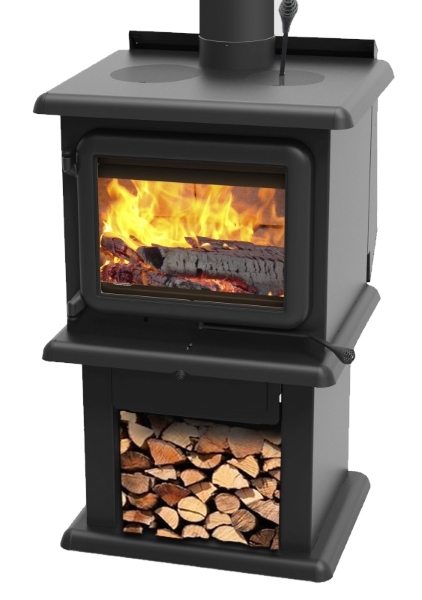The demand for electricity for heating and cooling homes and businesses continues to rise yearly, with electricity alone increasing by 1.8% per year (In 2050, electricity will reach a 50% increase to today’s numbers. With the increased demand comes higher energy costs. Toss in energy shortages from current world events, and you are looking at some eye-opening bills each month.
Now more than ever, it pays to reduce your electricity and fuel costs. The good news is that if you own a wood stove, you can, and the same strategies work when energy costs come back down, making them worth knowing for the long term. This is true of most wood stove models like those by Jøtul, Vermont Castings, Hearthstone, Lopi, and Morso.
Increasing your stove’s efficiency during cold months of the year helps you indulge in all the ambiance and coziness that make these stoves popular while feeling less pain in your wallet. Here are some powerful ways to boost that efficiency.
Choose the Right Wood
Not all firewood is created equal, and the dryness of that wood is also critical.
Some examples of quality dry woods are maple, oak, ash, birch, and most fruit trees. The dryer the wood is, the faster and larger your burn while increasing the chances that your fire will stay lit. Dryer wood also reduces smoke and the buildup of creosote, a harmful tar-like substance that reduces stove performance and creates fire danger inside your home.
Prioritize wood with low moisture content – ideally 15-20%, and look for seasoned woods. The term seasoned wood may sound like you are using wood cut during the fire season, but it is wood that has dried for a full season prior. The added storage time further dries the wood for a highly efficient burn.
The ideal wood and moisture content may not come cheap, but that’s what you want. The lower the cost, the less efficient the wood will be. Some physical signs of quality wood are lighter tones and bark that falls off easily. You can go even further by using a moisture meter to verify the moisture content.
Keep It Clean
Creosote, soot, and various critters like mice and birds can limit the draft and venting of your fire, reducing your efficiency. Plus, ash and dirt can build up, clogging air holes in your wood stove system. Regular cleaning and maintenance keep these issues to a minimum.
You should do minor cleaning after each fire and be prepared for more thorough cleaning and maintenance checks every few weeks as you use your stove. For a closer look at cleaning strategies and timing, see our article on Wood Stove Maintenance.
Regular cleaning may not sound exciting, but by making it a habit, you maximize your heat generation for maximum energy efficiency and safety. Plus, your stove parts last longer, decreasing your overall heating costs.
Wait for the Cold
A wood stove works best when the weather gets truly cold. The colder it is outside vs. inside, the better the draw and the better the fire burns. At the same time, you have less interior smoke and less trouble lighting the fire. Everything is easier.
Use Airflow to Your Advantage
Wood stoves may appear as simple fireboxes connected to piping, but there are other parts inside that help minimize fuel waste. The vents and valves in your stove help you control the airflow to maximize your burn, essentially acting like volume switches for your fire. With control over your fire, you can increase air to create an intense burn or reduce it to make a longer, hotter burn to maximize heat efficiency.
One example of this in action is a damper. When you start a fire, opening the disc-shaped metal door allows for plenty of oxygen for easier ignition and faster fire growth. When you hit the right temperature, closing the damper reduces the oxygen for a slower, hotter for increased efficiency. For more on how dampers work, see our full article.
An Energy-Efficient Wood Stove: The Best of Both Worlds
When you maintain regular cleaning and maintenance, burn the best types of wood, and keep a close eye on airflow, you fight against rising energy costs in the comfort of a warm and toasty home. Plus, these same habits help you when energy costs come back down, reducing wasted energy and repair costs while also keeping your home and family safe from fire danger.
The demand for electricity for heating and cooling homes and businesses continues to rise yearly, with electricity alone increasing by 1.8% per year (In 2050, electricity will reach a 50% increase to today’s numbers. With the increased demand comes higher energy costs. Toss in energy shortages from current world events, and you are looking at some eye-opening bills each month.
Now more than ever, it pays to reduce your electricity and fuel costs. The good news is that if you own a wood stove, you can, and the same strategies work when energy costs come back down, making them worth knowing for the long term. This is true of most wood stove models like those by Jøtul, Vermont Castings, Hearthstone, Lopi, and Morso.
Increasing your stove’s efficiency during cold months of the year helps you indulge in all the ambiance and coziness that make these stoves popular while feeling less pain in your wallet. Here are some powerful ways to boost that efficiency.


/1003/site-assets/logo.png)


